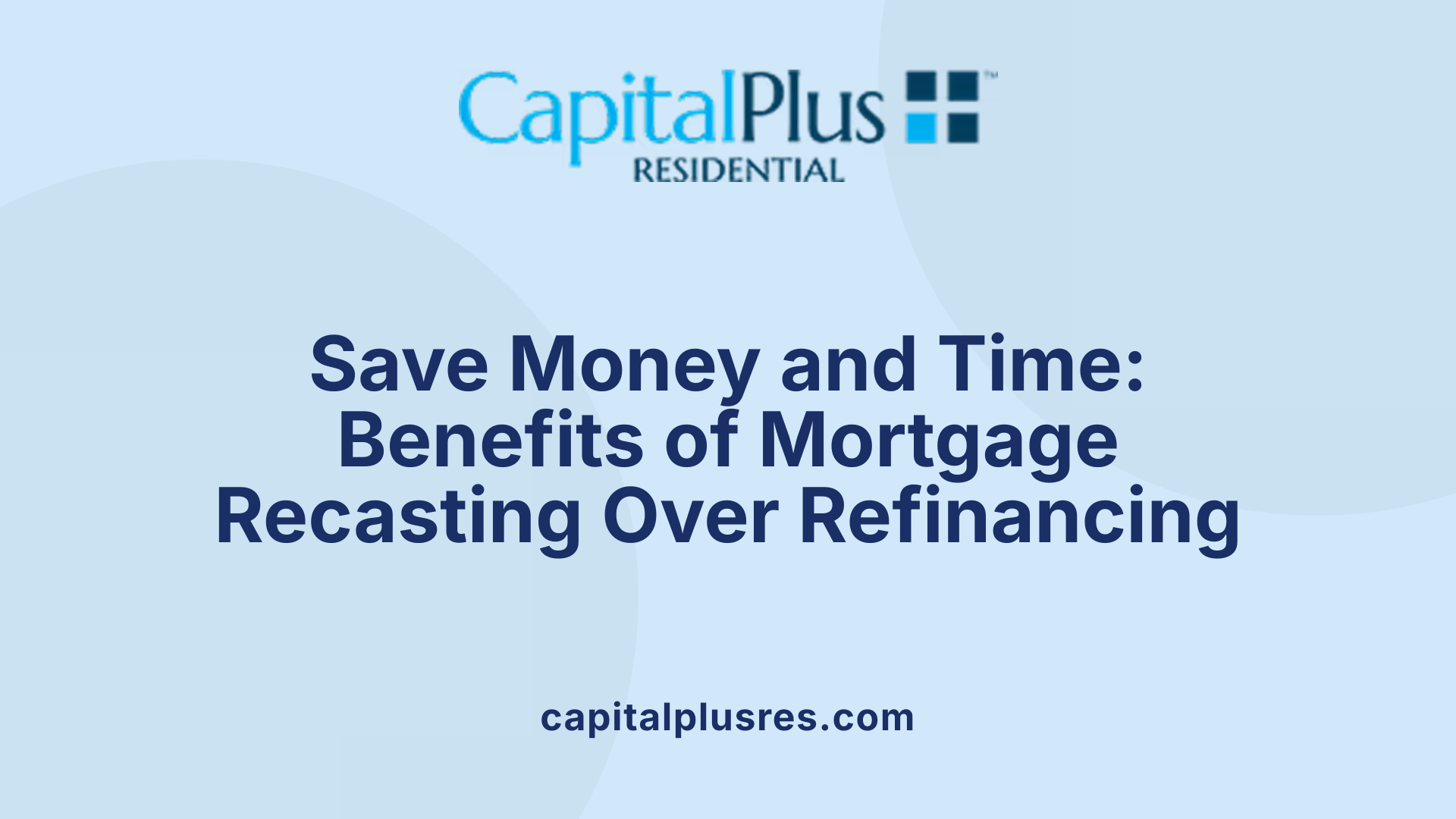Understanding Mortgage Recasting
Mortgage recasting offers homeowners a strategic way to lower their monthly mortgage payments without refinancing. By making a substantial lump-sum payment towards the principal balance, borrowers can reduce monthly expenses while keeping the original loan term and interest rate intact. This article explores the ins and outs of mortgage recasting, how it compares to refinancing, eligibility requirements, and why it could be a valuable tool in your financial toolkit.
What is Mortgage Recasting and How Does It Work?

Definition of Mortgage Recasting
Mortgage recasting, also known as re-amortization, is a process where a homeowner makes a large lump-sum payment toward their mortgage principal. This payment reduces the outstanding balance, and the lender recalculates the monthly mortgage payments based on the remaining balance and original loan term.
How Recasting Reduces Monthly Payments
By lowering the principal balance without changing the interest rate or loan term, recasting results in lower monthly payments. The loan's amortization schedule is adjusted, so payments shrink, but the timeline for full payoff remains the same. This differs from simply making extra payments, which reduce principal but don’t immediately reduce monthly installments.
Process Steps Including Lump-Sum Payment and Lender Recalculation
The mortgage recasting process typically involves these steps:
- Contact the lender to verify loan eligibility for recasting (usually conventional loans qualify).
- Make a substantial lump-sum payment, often between $5,000 and $10,000 or more, toward the mortgage principal.
- Pay a recasting fee, commonly ranging from $150 to $500.
- The lender recalculates monthly payments based on the lower principal, keeping the interest rate and original loan term unchanged.
Recasting usually takes around 45 to 60 days to complete.
Difference from Refinancing
Unlike refinancing, which replaces the original loan with a new one often at different terms and interest rate, recasting retains the existing loan contract. Refinancing involves credit checks, appraisals, higher fees, and restarting the loan term. Recasting is typically cheaper, faster, and less complicated, making it ideal for borrowers happy with their current interest rate.
Loan Terms and Interest Rate Remain Unchanged
Crucially, mortgage recasting does not affect the interest rate or length of the loan. Borrowers benefit from reduced payments without extending their loan term or undergoing extensive paperwork. This feature makes recasting especially valuable if market rates have risen since the initial loan was taken.
Additional Considerations
When obtaining a residential mortgage, borrowers should consider factors such as interest rates, loan terms, fees, repayment options, and lender reputation. Also important are personal credit scores, debt-to-income ratios, financial stability, down payment sizes, and property values to ensure a suitable mortgage choice.
Eligibility, Fees, and Typical Requirements for Mortgage Recasting

Eligible Loan Types for Recasting
Mortgage recasting is primarily available for conventional loans, including those backed by Fannie Mae® and Freddie Mac®. Adjustable-rate mortgages (ARMs) in their repayment phase may also qualify. However, government-backed loans such as FHA, VA, and USDA loans generally do not qualify for recasting, nor do many jumbo loans, HELOCs, bond loans, or interest-only loans.
Loans Not Eligible for Recasting
Borrowers with FHA, VA, or USDA-insured mortgages will typically need to explore refinancing or other options, as these loans are excluded from recasting programs. Additionally, many lenders do not offer recasting for jumbo loans or loans administered by Ginnie Mae.
Typical Lump-Sum Payment Requirements
A significant lump-sum payment towards the mortgage principal is essential to trigger recasting. Most lenders require a minimum of $5,000 to $10,000 or at least 10% of the unpaid principal balance before processing a recast. This principal curtailment reduces the loan balance and drives the recalculation of monthly payments.
Recasting Fees and Examples
Recasting involves a fee, usually ranging from $150 to $500, which is considerably lower than refinancing costs. For instance, Rocket Mortgage charges a $250 fee, while Newrez also charges $250. These fees cover administrative costs, including recalculating the amortization schedule.
Borrower Qualifications
To qualify, borrowers must typically maintain a solid payment history, often requiring at least two consecutive on-time payments before a recast is approved. Additionally, sufficient home equity is necessary, meaning the property value minus the remaining mortgage balance should meet lender requirements. Since recasting locks lump-sum payments into the loan, borrowers should ensure the funds are not needed elsewhere.
What Should Borrowers Consider?
When considering mortgage recasting, borrowers need to evaluate if their loan type is eligible, confirm that they have enough equity, and assess their payment history. They must also be prepared to make the required lump-sum payment and cover the recasting fee. This approach is especially effective for those who wish to lower monthly payments without refinancing and who prefer to maintain their current interest rate and loan term.
Benefits of Mortgage Recasting Compared to Refinancing and Extra Payments

How Does Mortgage Recasting Lower Monthly Payments Without Changing Loan Terms?
Mortgage recasting allows homeowners to make a large lump-sum payment toward their principal balance, which reduces their monthly mortgage payments by spreading the smaller balance over the original loan term. Importantly, the interest rate and loan term remain unchanged, so borrowers keep their existing favorable loan conditions.
How Does Recasting Reduce Total Interest Paid?
By lowering the outstanding principal early in the loan, recasting results in less interest accumulating over the life of the loan. Although the payoff date stays the same, less interest accrues monthly, yielding overall savings.
Why Are No Credit Checks or Home Appraisals Needed?
Recasting does not involve creating a new loan. Instead, the lender simply recalculates payments based on the reduced principal. Since there’s no loan underwriting, this process bypasses credit checks and home appraisals, making it quicker and simpler.
What Makes Recasting More Cost-Effective and Less Paperwork-Intensive Than Refinancing?
Recasting typically incurs a small fee—commonly between $150 and $500—far less than refinancing closing costs. Refinancing requires loan approval steps, credit checks, income verification, and an appraisal, involving significant paperwork and expense. Conversely, recasting is streamlined with only a lump-sum payment and a fee.
How Does Recasting Compare to Refinancing and Making Extra Principal Payments?
Refinancing replaces your original mortgage with a new loan, often resetting the loan term and potentially changing the interest rate. It allows access to home equity but usually involves higher costs and more complexity.
Making extra principal payments without recasting reduces the loan balance and interest but does not lower monthly payments automatically. Recasting recalculates payments based on the new balance to reduce monthly costs.
Borrowers satisfied with their current loan rate but seeking reduced monthly payments and less hassle often find recasting an ideal alternative to refinancing.
What Are the Benefits of Using Mortgage Brokerage Services?
Mortgage brokers provide expert guidance and access to various mortgage options, helping borrowers evaluate strategies like recasting or refinancing. This ensures homeowners maximize cost savings and select the best approach to lower their mortgage expenses.
Using Mortgage Brokerage and Residential Lending Services to Optimize Mortgage Strategies

What are mortgage brokerage services?
Mortgage brokerage services act as a bridge connecting borrowers with a wide range of lenders and mortgage products. Brokers evaluate your financial situation and goals to offer tailored loan options. They assist in preparing documentation and skillfully navigate through offers so you can secure favorable mortgage terms. This service can be invaluable for borrowers exploring options like mortgage recasting.
How does a mortgage broker differ from a lender in residential lending?
Mortgage brokers and lenders play distinct roles in the home loan process. Brokers represent the borrower by sourcing and comparing loan products from various lenders. They provide advice and present multiple options tailored to your needs. In contrast, lenders are the institutions that directly approve, fund, and service the mortgage loan. Choosing to work with a broker can give you broader access and guidance when considering strategies like recasting or refinancing.
What do residential lending services include?
Residential lending encompasses home purchase loans and refinance mortgages. This includes loan origination, underwriting, and servicing functions. Lenders offer a variety of mortgage products along with online tools, calculators, and customer support to assist borrowers. These services help you understand your loan options, including how mortgage recasting might lower monthly payments or reduce interest costs.
How do mortgage brokers assist with understanding recasting options?
Brokers help borrowers assess whether mortgage recasting suits their financial situation. They explain the benefits, such as reduced payments without refinancing, as well as eligibility requirements and lender policies. With their expertise, brokers can identify which lenders offer recasting, clarify associated fees, and guide borrowers through the recasting process to optimize savings.
Why is professional support important when considering recasting or refinancing?
Deciding between recasting and refinancing involves comparing costs, timelines, credit requirements, and loan features. Professional mortgage brokers and lending specialists provide objective advice and in-depth knowledge to help homeowners make informed decisions. Their support reduces errors, streamlines paperwork, and ensures borrowers choose the mortgage strategy best aligned with their goals.
| Aspect | Mortgage Broker | Mortgage Lender | Contribution to Recasting Decisions |
|---|---|---|---|
| Role | Intermediary sourcing loans | Approves and funds loans | Broader knowledge of recasting availability |
| Loan Options | Multiple lenders’ products | Typically one institution | Provides comparative recast feasibility |
| Customer Support | Guidance, advice, documentation help | Loan underwriting and servicing | Explains recasting impact and process |
| Eligibility Assessment | Helps evaluate borrower eligibility | Verifies credit, income, and loan criteria | Ensures borrower meets recasting requirements |
Engaging mortgage brokerage and residential lending services can empower homeowners with insights and tailored support, unlocking more effective mortgage strategies like recasting to reduce payments and optimize long-term financial health.
Practical Considerations and Scenarios for Using Mortgage Recasting
Common situations prompting recasting
Homeowners often choose mortgage recasting after receiving a financial windfall like an inheritance or bonus, or following the sale of another property. These events provide the lump-sum payment needed to reduce the mortgage principal and lower monthly payments.
Lump-sum payment sources
Funds for recasting typically come from savings, bonuses, inheritances, or proceeds from selling assets. Borrowers should ensure they have sufficient cash to meet minimum thresholds—often around $5,000 to $10,000—to qualify for recasting.
Timeline and process steps
The recasting process usually takes 45 to 60 days. Steps include contacting the lender to confirm eligibility, making the lump-sum payment, paying a recasting fee (commonly $150 to $500), and receiving a recalculated payment schedule.
Limitations and lender participation
Recasting does not allow access to home equity, unlike refinancing, so funds are tied up in the mortgage balance. Additionally, not all lenders offer recasting services, and it is typically limited to conventional loans, excluding FHA, VA, and USDA loans.
Estimating payment reductions
Using mortgage recast calculators or manual computations helps borrowers estimate how much their monthly payments will decrease after applying a lump-sum principal payment.
Financial stability benefits
By lowering monthly payments without resetting loan terms or interest rates, recasting improves monthly cash flow and supports long-term financial stability.
Considerations for obtaining a mortgage
Borrowers should evaluate their ability to make lump-sum payments, understand recasting timelines, and weigh the lack of equity access compared to refinancing to ensure this option aligns with their financial goals.
Is Mortgage Recasting Right for You?
Mortgage recasting presents an efficient and cost-effective method for homeowners wanting to reduce monthly payments without altering their loan's interest rate or term. It is especially advantageous for borrowers with a conventional loan who have received a financial windfall and wish to improve cash flow without the complexities and costs of refinancing. While not every loan qualifies and some restrictions apply, consulting with mortgage brokers or lending professionals can help you determine if recasting fits your financial goals. With relatively low fees, no credit checks, and a simplified process, recasting stands out as a compelling option to consider in managing your mortgage smartly.
References
- What Is Mortgage Recasting?
- Mortgage recasting: What you should know
- Mortgage Recast: A Flexible Way To Lower Your Monthly ...
- Recasting a mortgage: When it makes sense and how to do it
- The Benefits of a Mortgage Recast
- What is a Mortgage Recast?
- Exploring the Benefits of Recasting a Mortgage
- Mortgage Recasting: An Option to Lower Monthly Payments
- Mortgage Brokers: Advantages and Disadvantages
- What Is A Mortgage Broker And How Do They Help ...
Latest Blog


Get Pre-Approved Today
Start your secure online application now so you can get pre-approved for a mortgage (and close on your dream home) quickly within 5 minutes.









